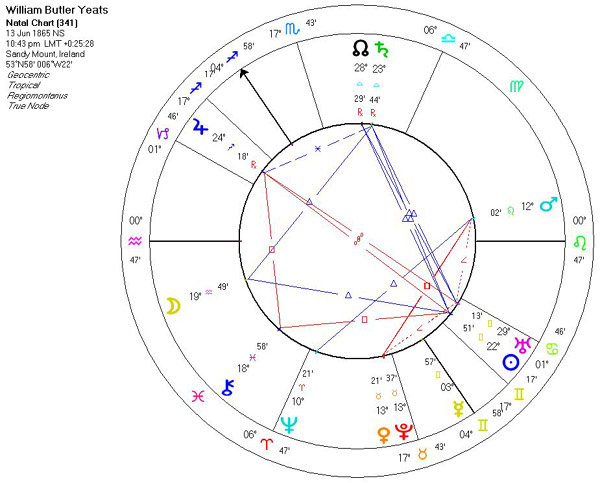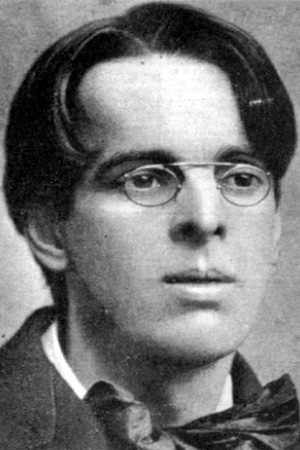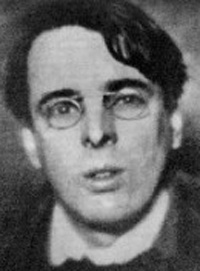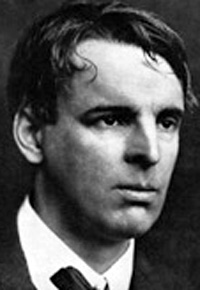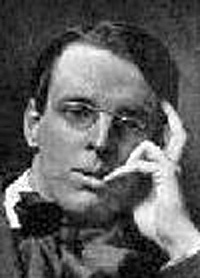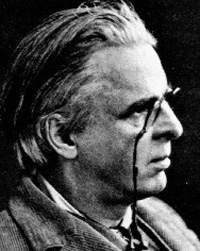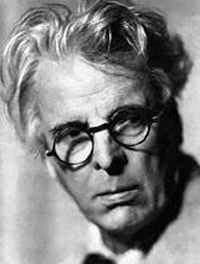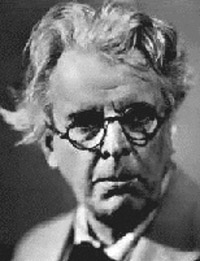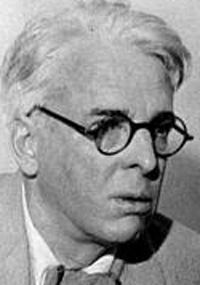Copyright Michael D. Robbins 2005
Astro-Rayological Interpretation & Charts
Quotes
Biography
Images and Physiognomic Interpretation
A line will take us hours maybe; Yet if it does not seem a moment's thought, our stitching and unstinting has been naught.
A pity beyond all telling is hid in the heart of love.
An intellectual hatred is the worst.
Do not wait to strike till the iron is hot; but make it hot by striking.
Education is not the filling of a pail, but the lighting of a fire.
Englishmen are babes in philosophy and so prefer faction-fighting to the labour of its unfamiliar thought.
Every conquering temptation represents a new fund of moral energy. Every trial endured and weathered in the right spirit makes a soul nobler and stronger than it was before.
I am still of opinion that only two topics can be of the least interest to a serious and studious mood - sex and the dead.
I balanced all, brought all to mind, the years to come seemed waste of breath, a waste of breath the years behind, in balance with this life, this death.
I hate journalists. There is nothing in them but tittering jeering emptiness. They have all made what Dante calls the Great Refusal. The shallowest people on the ridge of the earth.
In dreams begins responsibility.
Nor dread nor hope attend a dying animal; a man awaits his end dreading and hoping all.
Take, if you must, this little bag of dreams, Unloose the cord, and they will wrap you round.
The innocent and the beautiful have no enemy but time.
The only business of the head in the world is to bow a ceaseless obeisance to the heart.
Things fall apart; the centre cannot hold; mere anarchy is loosed upon the world, the blood-dimmed tide is loosed, and everywhere the ceremony of innocence is drowned; the best lack all conviction, while the worst are full of passionate intensity.
Think like a wise man but communicate in the language of the people.
We make out of the quarrel with others, rhetoric, but of the quarrel with ourselves, poetry.
I know not what the younger dreams—
Some vague Utopia—and she seems,
When withered old and skeleton-gaunt,
An image of such politics.
In Memory of Eva Gore-Booth and Con Markiewicz (l. 10–13). . .What’s water but the generated soul?
Coole and Ballylee, 1931 (l. 8). . .Unwearied still, lover by lover,
They paddle in the cold
Companionable streams or climb the air;
Their hearts have not grown old;
The Wild Swans at Coole (l. 19–22). . .They know that Hamlet and Lear are gay;
Gaiety transfiguring all that dread.
Lapis Lazuli (l. 16–17). . .I hate journalists. There is nothing in them but tittering jeering emptiness. They have all made what Dante calls the Great Refusal.... The shallowest people on the ridge of the earth.
I made my song a coat
Covered with embroideries
Out of old mythologies
A Coat (l. 1–3). . .Mysticism has been in the past & probably ever will be one of the great powers of the world & it is bad scholarship to pretend the contrary. You may argue against it but you should no more treat it with disrespect than a perfectly cultivated writer would treat (say) the Catholic Church or the Church of Luther no matter how much he disliked them.
ATTRIBUTION: William Butler Yeats (1865–1939), Irish poet, playwright. letter, Oct. 10, 1893, to author Laurence Housman. Collected Letters, vol. 1, ed. John Kelly (1986).
In an earlier letter (July 23, 1892), Yeats had written: “The mystical life is the centre of all that I do & all that I think & all that I write.... I have always considered myself a voice of what I believe to be a greater renaissance—the revolt of the soul against the intellect.”This melancholy London—I sometimes imagine that the souls of the lost are compelled to walk through its streets perpetually. One feels them passing like a whiff of air.
Letter, August 25, 1888, to writer Katharine Tynan (later Hinkson). Collected Letters of W.B. Yeats, vol. 1, ed. John Kelly (1986).
W.B. Yeats, Dublin, January 24th, 1908. Portrait by Alvin Langdon Coburn in Men of Mark (1913).
Born June 13, 1865 Dublin, Ireland
Died January 28, 1939 Menton, France
(June 13, 1865 – January 28, 1939) was an Irish poet, dramatist, mystic and public figure. Yeats was one of the driving forces behind the Irish Literary Revival and was co-founder of the Abbey Theatre.His early work tended towards a romantic lushness and fantasy-like quality best described by the title of his 1893 collection The Celtic Twilight, but in his 40s, inspired by his relationships with modernist poets such as Ezra Pound and his active involvement in Irish nationalist politics, he moved towards a harder, more modern style.
As well as his role as member of the board of the Abbey, Yeats served as an Irish Senator. He took his role as a public figure seriously and was a reasonably hard-working member of the Seanad. He was awarded the Nobel Prize for literature in 1923 for what the Nobel Committee described as "his always inspired poetry, which in a highly artistic form gives expression to the spirit of a whole nation". In 1934 he shared the Gothenburg Prize for Poetry with Rudyard Kipling.
Yeats was born in Sandymount, Dublin. His father, John Butler Yeats was descended from Jervis Yeats, a Williamite linen merchant who died in 1712 and whose grandson Benjamin married Mary Butler, daughter of a landed County Kildare family. At the time of his marriage, John Yeats was studying law, but soon abandoned his studies to take up a career as a portrait painter. His mother, Susan Mary Pollexfen, came from an Anglo-Irish family in County Sligo. Soon after his birth, Yeats moved to Sligo to stay with his extended family and he came to think of it as his true childhood home. The Butler Yeats family were highly artistic; William's brother Jack went on to be a well-known painter and his sisters Elizabeth and Susan were both involved in the Arts and Crafts movement.
Eventually, the family moved to London to enable John to further his career. At first, the Yeats children were educated at home. Their mother, who was homesick for Sligo, entertained them with stories and folktales from her native county. In 1877, William entered the Godolphin school, which he attended for four years. He appears not to have enjoyed the experience and did not distinguish himself academically. For financial reasons, the family returned to Dublin towards the end of 1880, living at first in the city center and later in the suburb of Howth.
In October, 1881, Yeats resumed his education at the Erasmus Smith High School, Dublin. His father's studio was located nearby and he spent a great deal of time there, meeting many of the city's artists and writers. He remained at the high school until December 1883. It was during this period that he started writing poetry and in 1885, Yeats' first poems, as well as an essay called "The Poetry of Sir Samuel Ferguson", were published in the Dublin University Review. From 1884 to 1886, he attended the Metropolitan School of Art (now the National College of Art and Design) in Kildare Street.
Even before he began to write poetry, Yeats had come to associate poetry with religious ideas and sentiments. Describing his childhood in later years, he described his "one unshakable belief" as "whatever of philosophy has been made poetry is alone... I thought... that if a powerful and benevolent spirit has shaped the destiny of this world, we can better discover that destiny from the words that have gathered up the heart's desire of the world."
Yeats' early poetry drew heavily on Irish myth and folklore and drew on the diction and colouring of pre-Raphaelite verse. His major influence in these years - and probably throughout the rest of his career as well - was Percy Bysshe Shelley. In a late essay on Shelley he wrote, "I have re-read Prometheus Unbound... and it seems to me to have an even more certain place than I had thought among the sacred books of the world."
Yeats' first significant poem was The Isle of Statues, a fantasy work that took Edmund Spenser for its poetic model. It appeared in Dublin University Review and was never republished. His first book publication was the pamphlet Mosada: A Dramatic Poem (1886), which had already appeared in the same journal, and this printing of 100 copies was paid for by his father. Following this was The Wanderings of Oisin and Other Poems (1889). The long title poem, the first that he would not disown in his maturity, was based on the poems of the Fenian Cycle of Irish mythology. This poem, which took two years to complete, shows the influence of Ferguson and the Pre-Raphaelites. It introduced what was to become one of his most important themes: the appeal of the life of contemplation vs. the appeal of the life of action. After The Wanderings of Oisin, he never attempted another long poem. His other early poems are lyrics on the themes of love or mystical and esoteric subjects.
The Yeats family had returned to London in 1887, and in 1890 Yeats co-founded the Rhymer's Club with Ernest Rhys. This was a group of like-minded poets who met regularly and published anthologies in 1892 and 1894. Other early collections include Poems (1895), The Secret Rose (1897) and The Wind Among the Reeds (1899).
In 1889, Yeats met Maud Gonne, a young heiress who was beginning to devote herself to the Irish nationalist movement. Gonne admired Yeats' early poem The Isle of Statues and sought out his acquaintance. Yeats developed an obsessive infatuation with Gonne, and she was to have a significant effect on his poetry and his life ever after. Two years after their initial meeting, Yeats proposed to her, but was rejected. He was to propose to Gonne a total of three more times: in 1899, 1900 and 1901. With each proposal, she rejected Yeats and finally, in 1903, married Irish nationalist John MacBride. This same year Yeats left for an extended stay in America on a lecture tour. His only other affair during this period was with an Olivia Shakespeare, whom he met in 1896 and parted with one year later.
Also in 1896, he was introduced to Lady Augusta Gregory by their mutual friend Edward Martyn and she encouraged Yeats' nationalism and convinced him to continue focusing on writing drama. Although he was influenced by French Symbolism, Yeats consciously focused on an identifiably Irish content and this inclination was reinforced by his involvement with a new generation of younger and emerging Irish authors. Together with Lady Gregory and Martyn and other writers including J M Synge, Sean O'Casey, Padraic Colum and James Stephens, Yeats was one of those responsible for the establishment of the literary movement known as the Irish Literary Revival (otherwise known as the Celtic Revival).
Apart from these creative writers, much of the impetus for the Revival came from the work of scholarly translators who were aiding in the discovery of both the ancient sagas and Ossianic poetry and the more recent folk song tradition in Irish. One of the most significant of these was Douglas Hyde, later the first President of Ireland, whose Love Songs of Connacht was widely admired.
One of the enduring achievements of the Revival was the setting up of the Abbey Theatre. In 1899 Yeats, Lady Gregory, Martyn and George Moore founded the Irish Literary Theatre. This survived for about two years but was not successful. However, working together with two Irish brothers with theatrical experience named William and Frank Fay and Yeats' unpaid secretary Annie Elizabeth Fredericka Horniman (a wealthy Englishwoman who had previously been involved in the presentation of George Bernard Shaw's Arms and the Man in London in 1894) the group established the Irish National Theatre Society. This group of founders was also able, along with J M Synge, to acquire property in Dublin and open the Abbey Theatre on December 27, 1904. Two of Yeats' plays were featured on the opening night. Yeats continued to be involved with the Abbey up to his death, both as a member of the board and as a prolific playwright.
In 1902, Yeats helped set up the Dun Emer Press to publish work by writers associated with the Revival. This became the Cuala Press in 1904. From then until its closure in 1946, the press, which was run by the poet's sisters, produced over 70 titles, 48 of them books by Yeats himself. Yeats spent the summer of 1917 with Maud Gonne, and proposed to Gonne's daughter, Iseult, but was rejected. In September, he proposed to Georgie Hyde-Lees, was accepted, and the two were married on 20 October. Around this time he also bought Ballylee Castle, near Coole Park, and promptly renamed it Thoor Ballylee. This tower served as his summer home for much of the rest of his life.
Mysticism
Yeats had a life-long interest in mysticism, spiritualism, and astrology. In 1885, he and some friends formed the Dublin Hermetic Order. This society held its first meeting on June 16, with Yeats in the chair. The same year, the Dublin Theosophical lodge was opened with the involvement of Brahmin Mohini Chatterjee. Yeats attended his first séance the following year. Later, Yeats became heavily involved with hermeticist and theosophical beliefs, and in 1900 he became head of the Hermetic Order of the Golden Dawn, which he had joined in 1890. After his marriage, he and his wife dabbled with a form of automatic writing.Yeats' mystical inclinations, informed by Hindu religion (Yeats translated The Ten Principal Upanishads (1938) with Shri Purohit Swami), theosophical beliefs and the occult, formed much of the basis of his late poetry, which some critics have attacked as lacking in intellectual credibility. W. H. Auden criticized his late stage as the "deplorable spectacle of a grown man occupied with the mumbo-jumbo of magic and the nonsense of India". Nevertheless, he wrote much of his most enduring poetry during this period. The metaphysics of Yeats' late works must be read in relation to his system of esoteric fundamentalities in A Vision (1925), which is read today primarily for its value shed on his late poetry rather than for any rigorous intellectual or philosophical insights.
A 1907 engraving of Yeats.In 1913, Yeats met the young American poet Ezra Pound. Pound had travelled to London at least partly to meet the older man, whom he considered "the only poet worthy of serious study". From that year until 1916, the two men spent the winters in a cottage in Ashdown Forest with Pound nominally acting as Yeats' secretary. The relationship got off to a rocky start when Pound arranged for the publication in the magazine Poetry of some of Yeats' verse with Pound's own unauthorised alterations. These changes were mostly designed to reflect Pound's distaste for Victorian prosody. However, both men soon found that they had a good deal to learn from each other. In particular, the scholarship on Japanese Noh plays that Pound had obtained from Ernest Fenollosa's widow provided Yeats with a model for the aristocratic drama he intended to write. The first of his plays modelled on Noh was At the Hawk's Well, the first draft of which he dictated to Pound in January 1916.
Yeats is generally conceded to be one of twentieth century's key English-language poets. Yet, unlike most modernists who experimented with vers libre, Yeats was a master of the traditional verse forms. The impact of modernism on Yeats' work can be seen in the increasing abandonment of the more conventionally poetic diction of his early work in favour of the more austere language and more direct approach to his themes that increasingly characterises the poetry and plays of his middle period, comprising the volumes In the Seven Woods, Responsibilities, and The Green Helmet.
Thanks in part to his exposure to the work of the younger modernists he met through Pound, the poetry of Yeats' middle period moved away from the Celtic Twilight mood of the earlier work. His political concerns also moved away from the arena of cultural politics in which he was so involved during the early years of the Revival. In his early work, Yeats' essentially aristocratic pose led to an idealisation of the Irish peasant and a corresponding willingness to ignore the very real poverty and suffering that was the daily lot of that class. However, the emergence of a revolutionary movement from the ranks of the urban Catholic lower-middle class left him little choice but to reassess his attitudes.
Yeats' new direct engagement with politics can be seen in the poem September 1913, with its well-known refrain "Romantic Ireland's dead and gone,/It's with O'Leary in the grave." This poem is an attack on the Dublin employers who were involved in the famous 1913 lockout of workers who supported James Larkin's attempts to organise the Irish labour movement. In Easter 1916, with its equally famous refrain "All changed, changed utterly:/A terrible beauty is born", Yeats faces his own failure to recognise the merits of the leaders of the Easter Rising because of their apparently humble backgrounds and lives.
Yeats was appointed to the Irish Senate (Seanad Éireann) in 1922 and one of his main achievements as a Senator was to chair the coinage committee that was charged with selecting a set of designs for the first coinage for the Irish Free State. He also spoke against proposed anti-divorce legislation in 1925. His own characterisation of himself as a public figure is captured in the line "A sixty-year-old smiling public man" in the 1927 poem "Amongst School Children". He retired from the Seanad in 1928 because of ill health. During his time as a senator Yeats warned his colleagues "If you show that this country, Southern Ireland, is going to be governed by Catholic ideas and by Catholic ideas alone, you will never get the North . . . You will put a wedge in the midst of this nation", a speech which was offensive to the orthodox Catholics who comprised the Irish government and political establishment at that time.
Yeats' essentially aristocratic attitudes and his association with Pound tended to draw him towards Mussolini, for whom he expressed admiration on a number of occasions. He also wrote some 'marching songs' (which were never used) for General Eoin O'Duffy's 'Blueshirts', a quasi-fascist political movement. However, when Pablo Neruda invited him to visit Madrid in 1937, Yeats responded with a letter supporting the Republic against Fascism. Yeats' politics are ambiguous: no friend of the Left (or democracy), he distanced himself from Nazism and Fascism in the last few years of his life. Nevertheless, it is unlikely that he ever reconciled himself to democracy in any meaningful sense. He was also deeply involved in the eugenics movement.
The Yeats Memorial in St. Stephen's Green, DublinIn his later poetry and plays, Yeats moved away from the directly political subjects of his middle years and started to write in a more personal vein. His subjects included his son and daughter and the experience of growing old. Yeats himself, in the poem "The Circus Animals' Desertion", which was published in his final collection, describes the inspiration for these late works in the lines "Now that my ladder's gone,/I must lie down where all the ladders start/In the foul rag and bone shop of the heart".
In 1929, he stayed at Thoor Ballylee for the last time. Much of the remainder of his life was outside Ireland, but he did lease a house in the Dublin suburb of Rathfarnham from 1932. He wrote prolifically through the final years of his life, publishing poetry, plays and prose. In 1938, he attended the Abbey for the last time to see the premier of his play Purgatory. The Autobiographies of William Butler Yeats was published that same year.
After suffering from a variety of illnesses for a number of years, Yeats died at the Hôtel Idéal Séjour, in Menton, France on 28 January 1939 at the age of 73. The last poem he wrote was the Arthurian-themed The Black Tower. Soon afterward, Yeats was first buried at Roquebrune, until, in accordance with his final wish, his body was moved to Drumecliff, Sligo in September, 1948, on the corvette Irish Macha. His grave is a famous attraction in Sligo. His epitaph, which is the final line from one of his last poems, Under Ben Bulben is "Cast a cold eye on life, on death; horseman, pass by!" Of this location, Yeats said, "the place that has really influenced my life most is Sligo." The town is also home to a statue and memorial building in Yeats' honour.
Irish poet, dramatist and prose writer, one of the greatest English-language poets of the 20th century. Yeats received the Nobel Prize for Literature in 1923. Between the Celtic dreams of THE WANDERINGS OF OISIN (1889) and the intellectual, often obscure poetry of the 1930s, Yeats produced a tremendous amount of works. In his early career Yeats studied William Blake's poems, Emanuel Swedenborg's writings and other visionaries, but later he began to confront reality with a new directness - and disillusionment. Central theme in Yeats's poems is Ireland, its history, folklore and contemporary public life.
William Butler Yeats was born in Dublin. His father was a lawyer turned to an Irish Pre-Raphaelite painter. In 1867 the family followed him to London and settled in Bedford Park. In 1881 they returned to Dublin, where Yeats studied the Metropolitan School of Art. He met there the poet, dramatist and painter George Russell (1867-1935), who was interested in mysticism.
Reincarnation, communication with the dead, mediums, supernatural systems and Oriental mysticism fascinated Yeats through his life. In 1886 Yeats formed the Dublin Lodge of the Hermetic Society and took the magical name Daemon est Deus Inversus. The occult order also attracted Aleister Crowley.
As a writer Yeats made his debut in 1885, when he published his first poems in The Dublin University Review. In 1887 the family returned to Bedford Park, and Yeats devoted himself to writing. He visited Mme Blavatsky, the famous occultist, and joined the Esoteric Section of the Theosophical Society, but was later asked to resign. In 1889 Yeats met his great love, Maud Gonne (1866-1953), an an actress and Irish revolutionary who became a major landmark in the poets life and imagination. However, she married in 1903 Major John MacBride, and this episode inspired Yeats's poem 'No Second Troy'. "Why, what could she have done being what she is? / Was there another Troy for her to burn." MacBride was later executed by the British.
Yeats was interested in folktales as a part of an exploration of national heritage and for the revival of Celtic identity. His study with George Russell and Douglas Hyde of Irish legends and tales was published in 1888 under the name Fairy and Folk Tales of the Irish Peasantry. Yeats assembled for children a less detailed version, IRISH FAIRY TALES, which appeared in 1892. (see also Wilhelm Grimm.) THE WANDERINGS OF OISIN AND OTHER POEMS (1889), filled with sad longings, took its subject from Irish mythology.
In 1896 Yeats returned to live permanently in his home country. He reformed Irish Literary Society, and then the National Literary Society in Dublin, which aimed to promote the New Irish Library. In 1897 he met Isabella Augusta, Lady Gregory, with whom he founded the Irish Literary Theatre. Yeats worked as a director of the theatre to the end of his life, writing several plays for it. His most famous dramas were CATHLEEN NI HOULIHAN (1902) and THE LAND OF HEART'S DESIRE (1894).
Ezra Pound, whom Yeats met in 1912, became his fencing master and secretary in the winters of 1913 and 1914. Pound introduced Yeats to Japanese Noah drama, which inspired his plays. In early 1917 Yeats bought Thoor Ballyle, a derelict Norman stone tower near Coole Park. After restoring it, the tower became his summer home and central symbol in his later poetry. In 1917 he married Georgie Hyde-Lee - they had a son and a daughter. However, before the marriage Yeats had proposed to Maud Gonne, but he was also obsessed with Gonne's daughter Iseult, who turned him down. During their honeymood Yeats's wife demonstrated her gift for automatic writing. Their collaborative notebooks formed the basis of A VISION (1925), a book of marriage therapy spiced with occultism.
The change from suggestive, beautiful lyricism toward the spare and tragic bitterness was marked in Yeats poem 'September 1913' in which he stated: "Romantic Ireland's dead and gone." During the civil war Irish Free State soldiers burned many of Yeats's letters to Maud Gonne when they raided her house. At the start of the war Yeats went to Oxford, but then returned to Dublin, becoming a Senator in the same year. As a politician Yeats defended Protestant interests and took pro-Treaty stance against Republicans. Maud Gonne's son, Sean MacBride, was imprisoned without trial under emergency legislation that Yeats had voted for.
In 1932 Yeats founded the Irish Academy of Letters and in 1933 he was briefly involved with the fascist Blueshirts in Dublin. While in Mallorca Yeats became seriously ill. He tried to meet Robert Graves who refused to see him. In his final years Yeats worked on the last version of A VISION, which attempted to present a theory of the variation of human personality, and published THE OXFORD BOOK OF VERSE (1936) and NEW POEMS (1938). Yeats died in 1939 at the Hôtel Idéal Séjour, in Menton, France. In 'Under Ben Buiben,' one of his last poems, he had written:
"The mystical life is the centre of all that I do and all that I think and all that I write."
Born in Dublin in the year 1865, William Butler Yeats would go on to become universally recognized by his peers as the greatest poet of this century writing in the English language. This recognition would come as early as 1828, a decade before his death with the publication of arguably his finest volume, The Tower (Fraser, 207). The son of one time attorney and later well known painter John Butler Yeats, W.B. Yeats was of partially Cornish and Gaelic decent, born near Dublin and raised between both England and Ireland.
Though born in Dublin and raised between England and Ireland, Yeats would develop, through his mother, a love for the west country of Ireland that would last all his life. Parts of his childhood and later vacations would be spent in County Sligo, the childhood home of both his parents. Yeats would later depict his beloved County Sligo in such works as "The Lake Isle of Innisfree". These works would serve as a symbol of his imaginative escape from the disappointments and unpleasant realities of life (Magill, 1957).
Yeats's childhood would be broad in education and personal experiences. Yeats would become a youth full of internal contradictions, often spawned by his desire to question all that he was taught. Spiritually, educationally, and personally, Yeats seemed to himself pulled in different directions, unable to decide on a clear path. These internal contradictions would come to shape the writer and man that he would one day become.
Much of childhood for Yeats was spent in London, where he attended the Godolphin School. At the age of fifteen, Yeats returned to Dublin and attended the Erasmus Smith School. In the tradition of his family, Yeats studied art from 1883 to 1886. Yeats also found intellectual stimulation in his fathers reading, often aloud. Through this and his own personal initiative, ...Yeats discovered Shakespeare, the Romantic poets, and the Pre-Raphaelites, explored popular works on Eastern mysticism, became interested in Irish myths and folklore, and perhaps most important, met the poets and intellectuals of the Irish Literary Revival, many of whom were to remain lifelong friends (Magill, 1957). Yeats soon discovered that his first love was poetry not painting. Soon began Yeats's love affair with Ireland and Irish literature that would last the rest of his life.
Yeats's spiritual outlook would play a significant role in his life and his works. Born into a Protestant family, with a paternal grandfather and great-grandfather having been Anglican clergymen, religion was a constant presence in Yeats's childhood. Yeats began to abandon the religion of his Rationalist upbringing and made a new religion out of poetic tradition (Kunitz, 1560). Yeats's interest in the occult and mysticism comes about early in life, an influence which would come to partially define Yeats to his world of readers, whether accurately or inaccurately.
Yeats sought in his writing to create a fresh tradition and a unique style. He attempted to create a literature that was Irish in subject matter and tone. Yeats strove to reawaken in his people a sense of the glory and significance of Ireland s historical and legendary past (Magill, 1958). Yeats found his vehicle to accomplish just that in Irish mythology and folklore. Offering an answer to Yeats's search for a personal and individual mythology, Yeats found a treasury of symbols hitherto unused in English poetry (Magill, 1958). Turning mythical figures into private symbols was the vehicle by which Yeats sought to translate his life to mystical events represented by the symbolism of Irish mythology. G.S. Fraser had this to say of Yeats and the type of man that his writing represented. The very fact that the young man could so easily concoct a new Religion for himself-out of Irish folklore...and anything that came handy-is evidence of a rather unreligious nature; evidence of a blithe and irresponsible temperament, that of a young man sure of his genius, and unconvicted of sin (Fraser, 211)..
Yeats adult life is often divided into three periods. The first was passed in London where he belonged to a group of fin de sieclepoets. Ernest Rhys and Yeats founded the Rhymers Club, of which Yeats was not the young star, but rather overshadowed by his contemporaries, Dowson and Lionel Johnson. During this time, Yeats wrote the Celtic twilight, highly indicative of his mystical tendencies and affiliations. A period of symbolism, ornamentation, easy music, and too great facility, he dabbled in the occult and sought the answers to life he could not seem to unravel in his own mind by means of traditional explanations.
Returning to Ireland in 1896, Yeats found himself caught up in the Irish Revolution. In the center of the conflict was the love of his life, Maud Gonne. It is at this point in his life that his plays and poems, though beautiful, began to repeat themselves (Kunitz, 1560). Yeats young life would soon be drastically changed, as he would meet Lady Gregory who, in essence, would save him from himself. Rehabilitating the confidence of the young writer and providing Yeats something to work for, Lady Gregory resurrected Yeats. Together, along with J.M. Synge, they founded the Irish Literary Theater, which would become the Abbey Theater and the Irish Academy. Yeats wrote several plays for the Abbey, though the most successful and well remembered were his patriotic propaganda piece, Cathleen ni Houlihan and the tragedy Deirdre. Here we see one of Yeats's greatest contributions to his Ireland in the founding of the Irish National Theater.
Writing and producing plays for the Abbey, the middle period of Yeats's life would come to a close. Yeats's work and focus would now take on a more practical value. The mysticism that had been found previously in his work would dwindle. His poetry became more based in reality, less ambiguous and more direct. This period would be the least mystical of his career.
A brief digression must be made in order to examine the influence of Maud Gonne on the life and work of W.B. Yeats. Yeats met the fiery revolutionary in 1889. He fell deeply in love with her and would propose to her in 1891, 1899, 1900, 1901, and 1916. Gonne had no use for Yeats's proposals. However, she did have a use for his talents. Gonne would use Yeats for his ability as an orator. Maud Gonne, dragging him at her heels on nationalist agitations, soon found that he was a natural orator and could easily dominate committees (Fraser, 210). Maud Gonne would continue to turn Yeats proposals down, yet she continued to be the catalyst for the finest love poetry Yeats would ever create. Gonne would once ask for Yeats's help in London, ending a brief but happy love affair with Olivia Shakespear. Sensing divided loyalty, Shakespear would end the affair and it was shortly thereafter that Lady Gregory would save Yeats from a potentially more tragic end, like the poets of the tragic generation (Fraser 210).
Yeats labeled himself a socialist, one who despised the middle classes, and his ideal Ireland was divided between a hard-riding Protestant of fine artistic tastes and a devout Catholic peasantry, full of instinctive wisdom and preserving a living folklore (Rogers, 384). In spite of Yeats's theoretic dissociation from contemporary Irish life and politics, he could not escape his environment, the less so because he was in love, and was to be for two decades (Magill, 1958). The love of Yeats life, Gonne would keep this mystic, otherworldly figure grounded in the real world, a world that love and heartbreak would not allow him to escape. This anchor to the world of reality would continue to drive Yeats to strive for the creation of the Ireland of his dreams. Still, later in life, Yeats would realize that the clerical and bourgeois Free State set up in 1922 bore little relation to his dreams.
After being turned down by Gonne yet again in 1916, Yeats would propose to her daughter, Iseult, in 1917 and once again be rejected. Later in 1917, Yeats suddenly married Georgie Lees. In 1918 he began restoration of his tower at Coole and settled on the coast. Yeats soon fathered a daughter in 1919 and a son in 1921. The third period of his life had begun.
The third stage of Yeats life was a diverse one, in which some of his best works would be created and he would come to push the world of Irish literature to a new realm. Becoming a member of the Irish Senate from 1922 to 1928, Yeats emerged heavily on the social scene. Meanwhile (it was years later before he acknowledged it), he had discovered that Mrs. Yeats was a medium, who did automatic writing (Kunitz, 1561). The mystic side of Yeats was reborn, incurring with it heavy criticism from his peers for his outlandish and deeply held beliefs. Unashamed and unafraid of the consequences, Yeats would face harsh ridicule by revealing such statements as his belief in fairies.
In 1923, Yeats would win the Nobel Prize for Literature. Soon Yeats himself realized what the world would soon admit, when he was young, he said, his Muse was old; now he was old but his Muse was young (Kunitz, 1561). Nobody argued with Yeats statement. One critic had this to say. He is perhaps the only poet in history whose last work was his best. The taut bareness of the phrases, the stark beauty, the sharpness, the simplicity, the objectivity, he had never achieved in youth came to him in old age (Kunitz, 1561). Yeats would continue to advance his art and poetry throughout the course of his life. Yeats was more of a revolutionary and more of a contributor to English Literature than any of his peers, and arguably one of the largest contributors in history.
W.B. Yeats was a complex man with a steady vehicle for his ideas. Yeats was a many of diverse interests and causes. Though involved in various movements, differing schools of thought, a constant search for the truth and a fight for the individuality and self-worth of Ireland, Yeats never abandoned his primary vehicle, poetry. Though he went on to write much more than simply poetry, he always came back to his first love. Yeats was a poet at his deepest, most personal level.
Yeats had the unique ability to take fantasy, mysticism ,and the unknown and use it as an analogy to examine and explain the human condition. In Yeats's poetry is seen a message as broad and diverse as the man himself. Always questioning, constantly striving to explain and make analogous to the folklore of his native land, Yeats poetry serves as a record of Yeats's personal struggle. One analysis of the poetry of Yeats capsulizes its meaning thusly, "What the poems record is the continuous conflict between the claims of a prophetic wisdom, a sense of insulation against the terrors of history, and, on the other hand, the claims, rewards, and pains of the moment" (Scott-Kilvert, 208). Still full of internal contradictions and constantly questioning conventional knowledge, Yeats would reach the twilight of his days. More fresh now and full of ideas, Yeats would continue to lead the way for his younger counterparts.
Yeats would die at seventy-three, disillusioned with his Ireland and his life, but that he loved them both still is unquestionable. Struggling to come to terms with reality and truth, Yeats would die with his best work to come, and his mind still able to produce it. He died perhaps the greatest poet yet created by Ireland, and the greatest of his time in England. Had he died at a younger age that might not have been the case. The undisputed leader of Irish intellectual life, Yeats saw himself, as Horace Gregory put it, to be a citizen of two worlds, the visible and the unseen, walking as envoy from each into the other (Kunitz, 1561). Desmond Fitzgerald said of Yeats work that, He opened to us the soul of our own country like a book.
